SaaS Deployment: DevOps Guide To Tenancy Architecture
- Nitin Yadav
- Blog
About
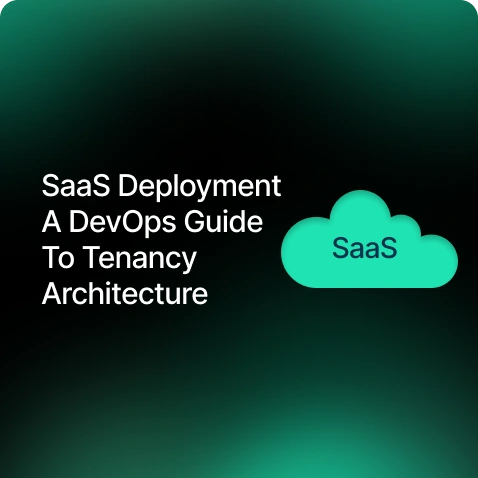
Industries
- Data Security, SAAS, Tenancy Architecture
Share Via
Software-as-a-service (SaaS)
SaaS applications not only bring about a transformative approach to software delivery but also introduce considerations about tenancy architectures. Within the DevOps field, deploying and managing multi-tenancy SaaS applications adds layers of complexity and opportunities.
From a deployment view, the chosen tenancy model impacts resource allocation, scalability solutions, and potential customization strategies. DevOps teams must ensure that the infrastructure and deployment pipelines are customized to support the specific tenancy model in use. While the underlying objectives of rapid, reliable, and repeatable releases remain consistent, the fine points of the tenancy architecture can dictate the specifics of implementation.
For DevOps professionals, understanding the importance of SaaS tenancy architecture is crucial. It provides context for deployment strategies, influences monitoring practices, and shapes the response to incidents and user feedback. As businesses continue to adopt SaaS solutions, a deep comprehension of tenancy, combined with expert DevOps practices, becomes necessary for successful, scalable, and sustainable software service offerings.
Let’s understand different tenancy Models
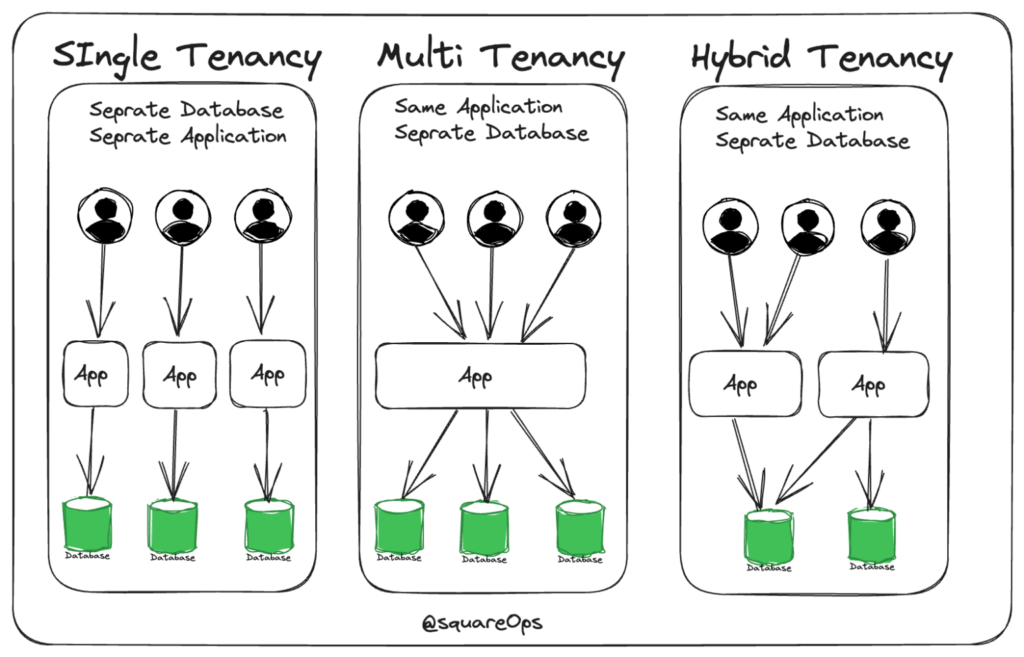
Imagine renting a space. There are different ways to do it, and each comes with its own set of features and limitations. Similarly, in the digital world, there are various methods to “rent” software. Here’s how the three main ways—Single Tenancy, Multi-Tenancy, and Hybrid Tenancy—compare:
1. Single Tenancy: The Independent House
Think of single tenancy as renting an entire house for yourself. Everything from the basement to the attic is yours. There are no shared spaces or shared resources.
What does this mean in the software world?
In a single tenancy model, each customer or ‘tenant’ gets their own standalone version of the software, complete with separate infrastructure like servers and databases. It’s like having software built just for you.
Why choose this?
If you prioritize customization, security, and having a system tailored precisely to your needs, single tenancy is a great fit. It’s often preferred by businesses that need to meet stringent compliance standards or want deep customization capabilities.
2. Multi-Tenancy: The Apartment Complex
Now, think of multi-tenancy as living in an apartment complex. Everyone has their own apartment, but the building’s structure, electricity, and water supply are shared.
In the software realm:
Multiple customers use the same software application, but each has their separate ‘space’ within that software. Even though they share the same system, they can’t access or see each other’s data.
Why go for this?
It’s efficient. With shared resources, it’s often more cost-effective, and maintenance is easier since a single update can benefit all tenants simultaneously. It’s suited for businesses looking for a more standardized solution with quicker deployment.
3. Hybrid Tenancy: The Duplex or Townhouse
Lastly, imagine hybrid tenancy as living in a duplex or a townhouse. You have your own private space but might share a wall or a yard with a neighbor.
Software-wise:
It’s a blend of the first two models. Parts of the software might be shared among some customers, while others get entirely dedicated and private space.
Why opt for a hybrid?
It offers a balance, providing a solution that can be fine-tuned to meet the distinct needs of various customer groups.
Let’s look at how they differ on different Criteria :
This table provides a side-by-side comparison of the three tenancy models across various dimensions. Each model has its strengths and weaknesses, and the best fit will largely depend on the specific needs and priorities of the organization or service provider.
Criteria | Single- Tenacy | Multi- Tenancy | Hybrid Tenancy |
|---|---|---|---|
Flexibility | Unparalleled customization. Tenants can deeply adapt software to fit their specific needs. | Limited customization due to shared resources. Major changes could affect all tenants. | Offers a balance. Some elements can be customized deeply, while others might be standardized. |
Security Concerns | Higher security as each tenant’s environment is isolated, reducing risk of widespread data breaches. | Potential security risks. A breach in the shared system might expose multiple tenants’ data. | Combines benefits of both models. |
Performance | Stable performance due to dedicated resources. No risk of other tenants impacting speed or uptime. | Traffic spikes from one tenant can potentially affect others due to shared resources. | Better price-to-performance than multi-tenancy. |
Maintenance | Challenging and resource-intensive. Each instance needs to be updated individually. | Easier maintenance. Single updates/patches benefit all tenants simultaneously. | Mixed approach. Some universal updates can be rolled out, while others might need tenant-specific attention. |
Complexity | Relatively straightforward as each tenant has its own isolated environment. | Complexity arises in ensuring data and functional isolation between tenants in a shared environment. | High complexity due to blending features of both models, requiring detailed architecture design and monitoring. |
Integration Ease | Simplified, as custom integrations can be implemented without considering other tenants. | Might be challenging. Integrations need to ensure they don’t disrupt the shared environment or other tenants. | Variable. Some components can easily integrate like in single tenancy, while others might have multi-tenancy challenges. |
Compliance | Easier to tailor to specific regulatory requirements due to the isolated environment for each tenant. | May pose challenges, especially if tenants have differing compliance needs. Universal changes could affect all. | Offers flexibility in compliance. Some standards can be universally met, while others can be tenant-specific. |
Cost Efficiency | Generally higher costs due to dedicated resources and infrastructure for each tenant | More cost-effective due to shared resources, leading to economies of scale. | A middle ground in terms of cost, depending on the specific architecture and flexibility to shift to higher tenancy plans. |
Bridging SaaS Challenges with DevOps Solutions
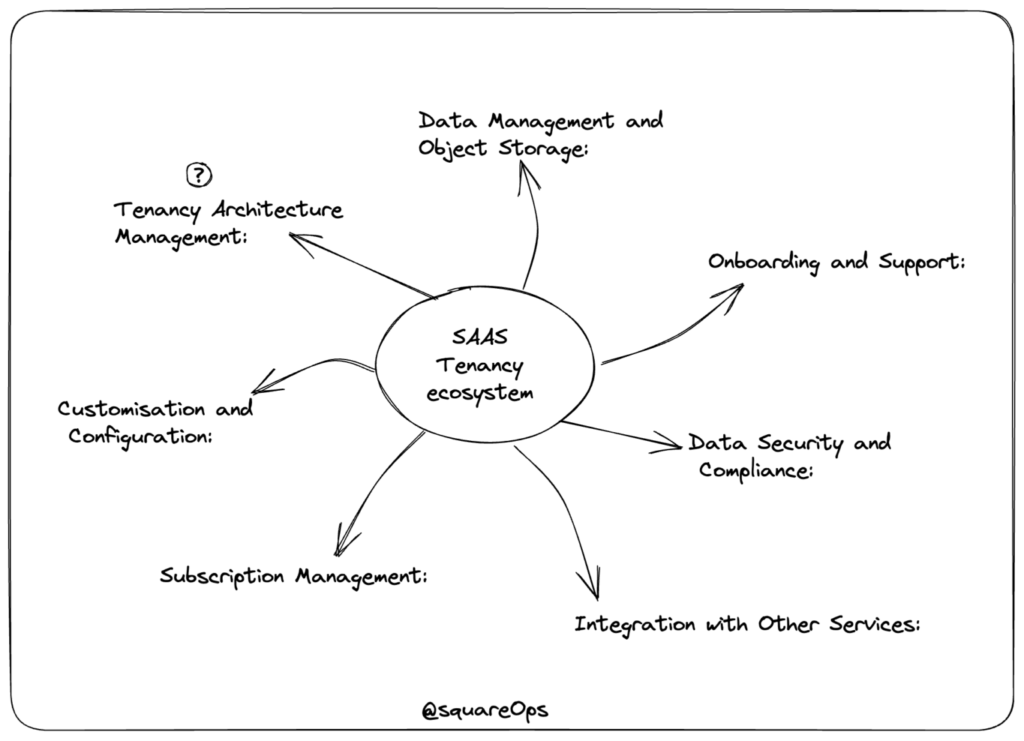
Let’s look at the top SaaS delivery challenges and how businesses need to think ahead of time to solve these challenges. A strategic DevOps approach is needed to address these challenges. Let’s uncover the influence of DevOps in resolving them and proving its indispensability in the SaaS ecosystem.
Criteria | Challenge | Solution |
|---|---|---|
Visibility | Managing hundreds of environments requires a comprehensive view of what’s running and where which can be a daunting task in multi-tenancy and hybrid tenancy setups | Implementing a single-pane view, like Argocd, for all tenants and versions, along with centralized monitoring systems built on top of toolchains like Grafana, can significantly enhance visibility and control |
Application Architecture | The complexity multiplies with architectures like microservices. For instance, an application with 25 microservices across 200 tenants results in 5000 total service environments | Utilizing “monorepos” is gaining popularity in managing such complexities efficiently |
Billing and Metering | Accurately tracking consumption is critical. Unmonitored features can lead to cost overruns, as observed with tenants occupying a disproportionate share of resources like S3 storage | Implementing quotas and accurate metering systems is essential to prevent such scenarios |
Deployment Strategy | Deploying releases in a controlled manner to numerous tenant environments is complex and often lacks a one-size-fits-all solution | Develop a customizable automation process, possibly with manual triggers, ensuring that once initiated, the deployment is fully automated, including checklists and thorough testing |
Data Management | Isolating and encrypting tenant data is crucial in SaaS hosting to prevent data mingling in shared environments | Where possible, use separate cloud accounts or aim for physical data isolation in the cloud |
Automation in Tenant Onboarding | Provisioning infrastructure, databases, and application configurations, and integrating new tenants into release and monitoring systems is intricate | Leveraging platform engineering techniques and tools like Jenkins, Terraform, Docker, Kubernetes, and Helm is vital. Purpose-built platforms, such as Atmosly , can also streamline these processes |
Conclusion
The complexity and dynamism of this domain require a strategic approach that not only confronts existing hurdles but also anticipates future complexities.
This is where DevOps emerges as an indispensable framework. It plays a crucial role in addressing and resolving the challenges in the SaaS ecosystem. From ensuring streamlined visibility across numerous environments to managing the complexities of application architecture, billing, metering, and deployment strategies, DevOps provides the agility and precision necessary in this complex landscape. Moreover, it ensures the secure and isolated management of data, crucial for maintaining customer trust and compliance in shared service environments.
In essence, DevOps stands as the cornerstone in the evolving world of SaaS, proving itself time and again as the key enabler for scalable, efficient, and secure software service delivery. Its role in anticipating challenges and providing adaptive solutions reinforces its status as an integral component of any successful SaaS strategy, especially in multi-tenant service delivery.
Frequently asked questions
SaaS tenancy models include Single-Tenant, where each customer gets their own isolated instance; Multi-Tenant, where multiple customers share the same instance; and Hybrid, a mix of both, balancing cost and customization.
Software-as-a-Service (SaaS) is a cloud-based service where applications are hosted and managed by a third-party provider and made available to users over the internet. Rather than installing and maintaining software on individual devices or servers, users access the application through a web browser. SaaS providers handle the underlying infrastructure, software updates, maintenance, and security.
Challenges include maintaining data isolation, preventing resource contention, supporting customizations, scaling efficiently, and ensuring security without compromising performance for all tenants.
DevOps helps by automating security patches, ensuring role-based access controls (RBAC), using infrastructure-as-code, and providing continuous monitoring for rapid threat detection and response.
Single-tenant offers isolated environments for each customer, allowing more security and customization, while multi-tenant shares a single environment among customers, reducing costs but requiring robust data isolation.
DevOps leverages containerization tools like Docker and orchestration systems like Kubernetes to dynamically scale SaaS applications based on demand, ensuring high availability and performance.
Yes, many SaaS providers offer Hybrid Tenancy, providing both shared and dedicated instances to balance cost efficiency with tenant-specific customization needs.
Tools like Jenkins, GitLab CI, Terraform, Docker, and Kubernetes are commonly used in DevOps pipelines for continuous integration, deployment, containerization, and monitoring in SaaS applications.
Data isolation techniques such as encryption, tenant-specific data stores, and RBAC ensure privacy in multi-tenant environments, with DevOps automating their application consistently across the platform.
DevOps improves SaaS by automating deployments, enabling faster updates, enhancing scalability, ensuring security, and allowing proactive monitoring, leading to better customer experience and uptime.
Related Posts
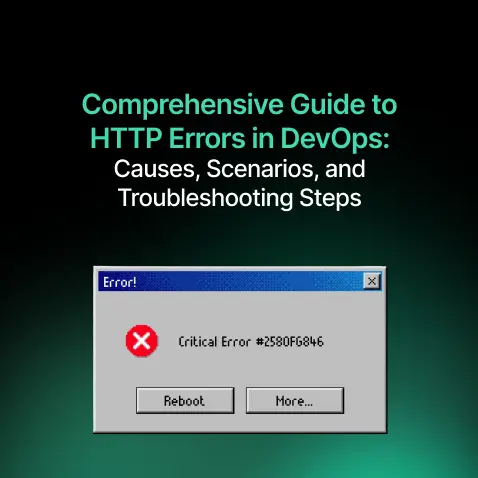
Comprehensive Guide to HTTP Errors in DevOps: Causes, Scenarios, and Troubleshooting Steps
- Blog
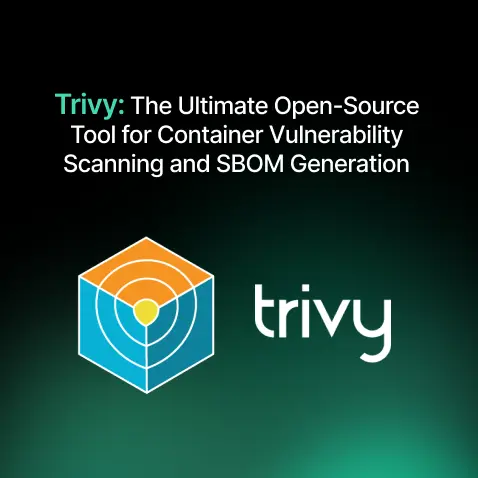
Trivy: The Ultimate Open-Source Tool for Container Vulnerability Scanning and SBOM Generation
- Blog
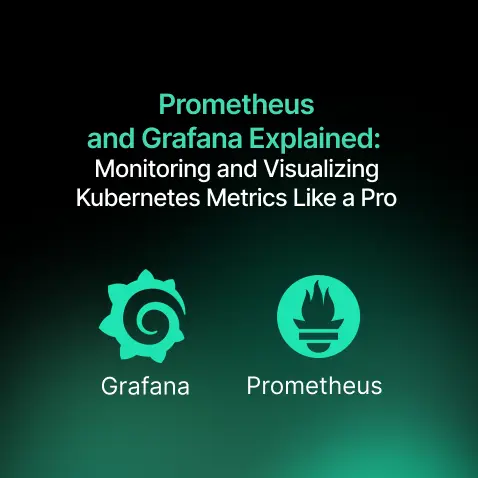
Prometheus and Grafana Explained: Monitoring and Visualizing Kubernetes Metrics Like a Pro
- Blog
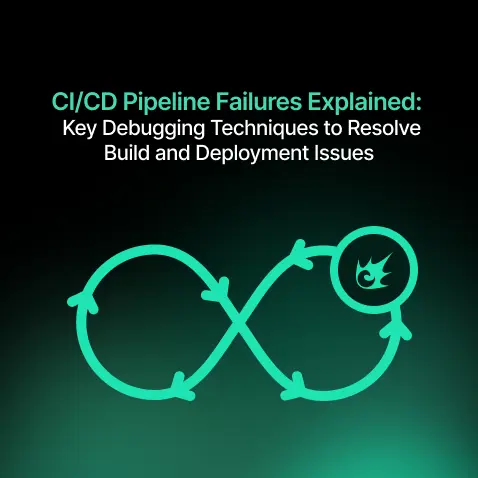
CI/CD Pipeline Failures Explained: Key Debugging Techniques to Resolve Build and Deployment Issues
- Blog
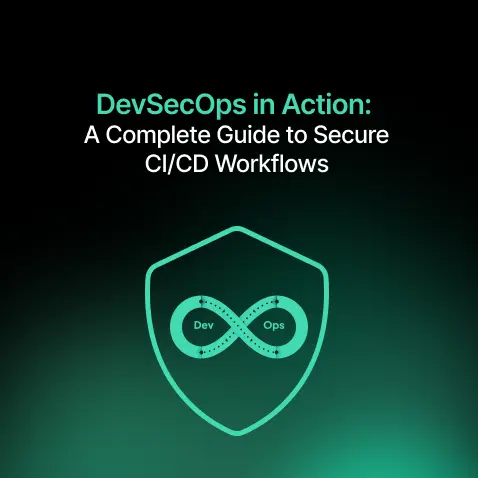
DevSecOps in Action: A Complete Guide to Secure CI/CD Workflows
- Blog
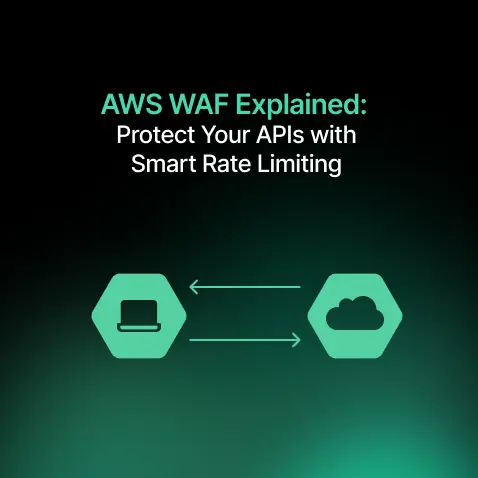
AWS WAF Explained: Protect Your APIs with Smart Rate Limiting
- Blog

